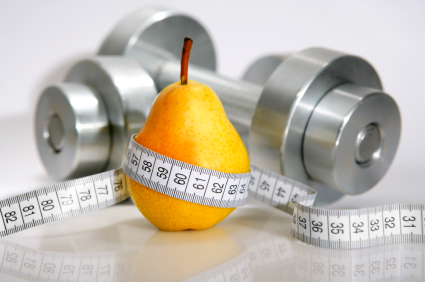How to Lose Stomach Fat Without Exercise or Dieting
Losing weight is an extremely popular fitness goal: over half of Americans list it as important to them.[1] Many people consider their stomachs to be especially troublesome, and research shows that stomach fat is in fact the most dangerous to your health.[2] While you will not achieve massive weight loss without diet and exercise, there are a few things you can do to slim your stomach line without heading to the gym or starving yourself.
Steps
Method 1 Mimicking Weight Loss Temporarily
-
1
Try tummy-control garments. There have never been more options in the undergarment industry for clothing that tighten, firm, and shape the midsection. Made mainstream by Spanx, tummy-control garments are available in many types for people of most sizes.
- Women's undergarments include tummy control pantyhose, panties, high-waisted shorts, body suits, camisoles, and tank tops made of Lycra, elastic, or some combination. Most mainstream undergarment brands for women carry control top styles, but the most popular include Spanx, Soma, and TC Shaping. Buy your normal size and expect it to run small.
- There are many options for men, including Spanx or Sculptees brand tank tops for men that target the abdominals. These are essentially compression shirts that whittle the appearance of the midsection. While results will vary, these companies claim their products can reduce the midsection by 3-5".
-
2
Take advantage of current trends in corseting and waist training. This method involves wearing a binding garment across the abdomen. If done in moderation, corseting can create a thinner silhouette without any other lifestyle changes.
- Some celebrities swear by corseting as a weight loss mechanism, and although doctors say it won't actually help you lose fat cells, it can help you lose weight by cinching in your stomach as you eat so that you don't have as much room to overeat.[3]
- Be careful about wearing these too tight or too frequently. Because they can reduce your stomach capacity, you might vomit after eating even a normal sized meal. They can also contribute to heartburn.[4]
- Purchase your corset at a store with a knowledgeable sales staff, who can help you fit it correctly and learn to lace it appropriately so that it is not too tight.
-
3
Consider a body wrap. Body wraps are spa treatments that claim to detoxify and slim the midsection. With training, these can also be done at home. While the process can vary, most involve several steps and the application of several types of body products.[5]
- The aesthetician will start by massaging and applying a body scrub to your midsection, which will then be rinsed in a shower. The body scrub will contain a variety of herbs and minerals thought to cleanse the skin of impurities and reduce the appearance of fat or cellulite.
- The body will then be rubbed with a lotion or oil containing other emollients and properties.
- Next, the midsection will be securely wrapped in linen, plastic, or thermal sheets, and then an electric heated blanket will be used to warm the body for about 30 minutes, which will cause sweating. This step in particular is thought to remove impurities and reduce the appearance of fat.
- After removing the blanket and wraps, the midsection will be massaged again to increase blood flow.
- While this process is not supported for weight loss, many clients feel that it reduces the appearance of stomach fat and cellulite, especially with repeated treatments. Due to the sweating process, it is not uncommon for clients to experience a loss of a couple of inches, although this will be temporary.[6]
-
4
Reduce your water weight. The body can retain water for various reasons, giving a bloated appearance particularly around the waist. Reducing water weight will temporarily slim the waistline.[7]
- Hydrate. In many cases, water retention is the body's effort to prevent dehydration when you are not taking in enough water per day. This is especially true in hotter months. Be sure you are drinking at least 8 cups of water a day, which will help flush out your system and reduce bloating and puffiness.[8]
- Reduce your sodium intake. Excess salt causes the body to retain water. Avoid processed foods and restaurant food, which tends to contain more salt than is recommended. You should consume no more than 1,500 mg of sodium per day.[9]
- Reduce your alcohol and coffee consumption. These drinks are known to cause dehydration, which can cause water retention in the body (as the body struggles to hold onto whatever water it can). [10]
Method 2 Changing Your Lifestyle
-
1
Avoid swallowing air. This might seem like a strange suggestion, but swallowed air is one of the biggest causes of bloating, which contributes to a rounder midsection. Simply reducing the amount of air you swallow throughout the day can trim down your tummy measurements.
- Avoid carbonated beverages, even those with zero calories like carbonated water. Beverages with air in them fill your abdomen with air, which causes a bloated appearance.
- Avoid smoking. Smokers who inhale smoke also tend to swallow it, which bloats their stomachs.
- Avoid chewing gum and talking while eating. Both of these habits lead to swallowed air.
-
2
Practice good posture. Changing the way you carry yourself and sit won't make stomach fat disappear, but it will make you look slimmer by helping your body fat distribute properly across the torso rather than gathering at the midsection. Try to keep your upper body straight, your shoulders pulled back, and your head high.
- When you sit, your buttocks should touch the back of your chair, and all three normal back curves should be present in your back (meaning a small towel or washcloth rolled up should fit above your buttocks).[11]
- When you stand, keep your shoulders back, pull in your stomach, and keep your feet about hip width apart.[12]
- If you're willing to do a little exercise, movements that strengthen your core and back can make it easier to maintain your posture while tightening up the muscles around your midsection. Try adding a few light crunches and easy back exercises to your schedule as you improve your posture.
-
3
Get enough sleep. Sleeping doesn't burn fat on its own, but it is a crucial part of weight loss efforts. This is mainly because sleep deprivation (not getting enough sleep) makes most aspects of weight loss more difficult. When you aren't well rested, it's hard to motivate yourself to get up and move. It's also hard to control cravings: you're more likely to act on impulses to eat junk food when you're already drained of energy.[13]
- While everyone's sleep needs are different, the majority of adults need about seven to nine hours per night. Children and elderly people tend to need more.[14]
-
4
Find a fitness-positive support network. Surrounding yourself with people who are committed to healthy living can help you live healthier. Hanging out with health-conscious people gives you more opportunities to participate in activities that lead to weight loss. Make an effort to spend time with people who enjoy hobbies that promote healthy living, like walking, sports, cycling, nutritious home cooking, and so on. Limit your time with people who have unhealthy hobbies like eating junk food, binge-drinking, and watching hour after hour of television.[15]
- If you don't have anyone in your family or circle of friends who is interested in health-conscious activities, don't be afraid to make new contacts. Join an intramural sports team or start participating in pickup games at your local park. Take a healthy cooking course or join a spin class at your local community center. There are many healthy ways to meet people — it's up to you!
-
5
Start tracking your weight. Some nutrition experts suggest that having an accurate idea of your own weight can promote healthy living.[16] Keeping track of your weight forces you to think healthy — if the numbers on the scale start to go up, you'll know that it's time to reconsider your habits.
- A person's weight can fluctuate by as much as 10 pounds from day to day. To get an accurate average, measure yourself at the same time every day (like right after you get up). At the end of the week, add up your measurements and divide by seven. The number you get will be close to your "true" average weight.
Method 3 Changing Your Eating Habits
-
1
Drink plenty of water. If you drink soda, sports drinks, or other high-calorie beverages throughout the day, try replacing them with water. You'll get the same level of hydration and fullness while cutting down on your calories. Keep it up and you can achieve mild weight loss without any extra effort.
- The health benefits of water are well-documented. Drinking water energizes muscles, keeps skin looking healthy and clear, and provides a boost of energy.[17] Best of all, it's zero-calorie, so you can drink as much as you want. See our tips on working water into your daily schedule for more great ideas.
- Don't be fooled into swapping soda for fruit juice, which is full of calories. The process of juicing removes all the healthy fiber from fruit and leaves nothing but sugar behind.[18] Stick with water or zero-calorie flavored waters for the most tummy-friendly hydration.
-
2
Eat smaller meals more frequently. Instead of three large meals a day, try eating several smaller meals of a few hundred calories. This can reset your hunger cues so that you will know when you are actually hungry versus eating out of habit.
- One convenient way to reduce your portion sizes is simply to use a smaller plate. Smaller plates can make the same amount of food appear larger due to something called the Delboeuf illusion.[19] You're essentially "tricking" your brain into being satisfied with less food.
-
3
Measure out each serving of food. Don't trust your eyes to tell you how much to eat — instead, use your brain. With recent trends in commercial cuisine tending towards large portions, many people now have a distorted idea of what a normal portion of food looks like. Use measuring cups and the information on the "Nutrition Facts" section of your food's packaging to ensure you eat one serving at a time. You may even want to invest in a simple food scale.
- Many common foods have serving sizes that are easy to visually memorize. A few common examples are below (you can view more here):
-
- Vegetables and fruit: about the size of your fist
- Meat, fish, or poultry: about the size of your palm (minus the fingers)
- Cheese or fatty spreads: about the size of your thumb
- Carbohydrates (rice, pasta, etc.): about the size of a cupcake wrapper
-
- Many common foods have serving sizes that are easy to visually memorize. A few common examples are below (you can view more here):
-
4
Eat breakfast. Many Americans skip breakfast[20] and then overcompensate for their resulting hunger by overeating at lunch and dinner.
- Ensure that your breakfast contains at least one item from three food groups: dairy, fruit, and grains.[21]
- A healthy breakfast for a 150 pound adult is about 300-400 calories.
-
5
Make smart food choices. A healthy diet is more friendly to the waistline than a non-healthy one, even if the calorie content is the same.
- Eat fresh fruits and vegetables instead of processed snacks. Processed foods have added preservatives, artificial ingredients, and are often full of carbohydrates, sugar, and fat. Fresh foods give you more nutrition per calorie than processed, carbohydrate heavy snack foods like chips or crackers. Processed foods also tend to contain more salt, which retains fluid and can lead to excess weight stored around the midsection.
- Never snack directly out of the bag or carton. One study found that people given a large bucket of popcorn ate 44% more popcorn than those given smaller buckets.[22] It's much easier to overeat when a large portion of food is in front of you. Instead, pour one serving of the snack into a bowl, then put the package away.
-
6
Keep your portions under control when you eat away from home. Controlling portions at home when you sit down for a meal is often easier than at a restaurant, where portions sizes for one meal often contain the recommended calories for one person for an entire day, or at a friend's house, where you cannot control what goes into the meal. Luckily, there are a few things you can do to control your portion size in places where you don't have perfect control over your food:[23]
- Plan what you will order ahead of time. Many restaurants have websites with complete nutritional information for their menus, so you can make a smart choice before you even leave your house.[24]
- When you're at a restaurant, ask the waiter to bring a doggy bag at the same time as your food. Measure out one portion, then put the rest in the bag right away. You'll be less tempted to mindlessly continue eating as you talk with your companions.
- When dining at another person's house, don't be afraid to ask for a small portion. This way you can clean your plate, instead of leaving a portion of food behind and potentially offending your host.
- When shopping, pick individually-sized foods, rather than foods that come in large containers. For instance, instead of buying a carton of ice cream, pick up a package of popsicles or ice cream sandwiches.
-
7
Switch to foods that leave you feeling fuller longer. When it comes to reducing your tummy line, it's not all about how much you eat, but also what you eat that counts. Certain foods give short "bursts" of energy and satisfaction, but leave you hungry before your next meal. Instead of these foods, focus on alternatives that offer long-term satisfaction.
- Filling foods that offer longer periods of satisfaction include whole-grain breads, rices, and pastas, oats, nuts, water, lean meats and fish, eggs, green vegetables, beans, and legumes.[25]
- Non-filling foods include sodas, processed snack foods, "white" breads, rices, and pastas, candy, and starches.
-
8
Eat slowly. When you eat quickly, you can swallow a surprising amount of food before you start to feel full and satisfied. On the other hand, eating slowly gives you plenty of time to feel full and stop eating before you've consumed more calories than you need. There is even evidence that this can promote the release of specific hormones that are responsible for the feeling of fullness in the brain.[26]
- Take time to eat your food. Concentrate on chewing each bite 10-20 times and take sips of water between each bite. Set the fork or spoon down between each bite. If you can, eat with someone else so you can pause to chat during your meal.
- Try setting a timer for 20-30 minutes at the start of your meal. Pace yourself so that you don't take the last bite until the timer goes off.
- When you finish your food, take a break from eating, even if you still feel a little hungry. Give your body a chance to register as having a full stomach, which can sometimes take a while. Only help yourself to seconds if you still feel hungry after another half an hour.
-
9
Eat in peaceful, quiet locations. Research suggests that eating in relaxing environments leads people to eat less overall. On the other hand, eating in loud, busy, chaotic environments can lead to over-eating. While the root cause isn't certain, this may be because these sorts of situations distract from feelings of fullness by creating mild anxiety.[27]
- One common cause for rushed, panicked eating is being late to school or work. Fixing this is a matter of adjusting your schedule. Consider getting up earlier so you have a chance to enjoy a relaxed breakfast before you leave.
-
10
Record your meals. Merely keeping track of what you eat can be an enlightening experience. You may be surprised to learn that you normally eat more than you think you do. Try writing your meals and snacks in a notebook you carry with you every day. Be sure to note the number of servings you eat for each as well as the calorie content per serving.
- There are also a variety of free websites and apps that make it convenient to keep track of your daily food choices. Myfitnesspal and Fatsecret.com are two popular, easy-to-use choices.[28][29]
-
7 Ways To Boost Your Metabolism—No Intervals Required
Sure, interval training is the best way to torch serious calories. But
-
Fast Weight Lose - Top Ten Weight Loss Tips
If you add the below mentioned weight loss tips in your day-to-day li
-
Weight Loss Tips To Help You Lose 10 Pounds By Easter
If losing weight is your goal, there are a few necessary weight loss
-
Buffets and Weight Loss
Committed dieters know that an overflowing buffet can wreak havo
-
How To Lose 10 Pounds Fast
There are many tricks, pills, fad diets available if you want to lose
-
All Your Weight Loss Questions Answered Here
Do you want to lose weight? You’ve come to the right place
- DON'T MISS
- Simple Ideas On How To Lose Some Weight
- 6 Fast Weight Loss Tips For Busy People
- The Healthiest Time To Eat During The Day Is...
- Enviga this weeks newest scam?
- Tips For Losing Weight Fast
- Meet the Writer Who Tried 14 Insane Celebrity Diets
- Methods For Reducing Your Weight Easier
- 6 Strategies Nutritionists Use To Break Bad Eating Habits For Good
- How to Fight and Eliminate Teenage Obesity?
- Jennifer Hudson on Oprah




